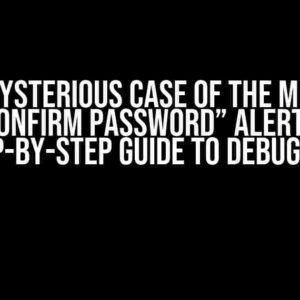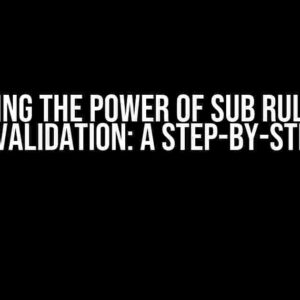Authentication is a crucial aspect of securing online communication, and using a .pem certificate with a web socket client is an excellent way to add an extra layer of security to your applications. In this article, we’ll delve into the world of .pem certificates and web sockets, explaining how to use them for authentication. Buckle up, folks, and let’s dive in!
What is a .pem Certificate?
A .pem certificate is a type of digital certificate that contains a public key, private key, or a combination of both. PEM (Privacy Enhanced Mail) is a file format used to store cryptographic keys and certificates. .pem certificates are commonly used for securing web servers, APIs, and web sockets.
Why Use a .pem Certificate for Authentication?
Using a .pem certificate for authentication provides several benefits, including:
- Secure Communication**: A .pem certificate ensures that the communication between the client and server is encrypted, protecting sensitive data from eavesdropping and tampering.
- Identity Verification**: A .pem certificate verifies the identity of the client or server, establishing trust and ensuring that only authorized parties can access the application.
- Easy to Implement**: Integrating a .pem certificate with a web socket client is relatively straightforward, especially when compared to other authentication methods.
Preparing Your .pem Certificate
Before we dive into using a .pem certificate with a web socket client, let’s cover the preparation process:
Generating a .pem Certificate
To generate a .pem certificate, you can use tools like OpenSSL or Keytool. Here’s an example using OpenSSL:
openssl req -x509 -newkey rsa:2048 -nodes -keyout mykey.pem -out mycert.pem -days 365 -subj "/C=US/ST=State/L=Locality/O=Organization/CN=example.com"This command generates a self-signed certificate, but you can also use a certificate authority (CA) to issue a certificate.
Converting to PEM Format
If your certificate is in a different format, such as .crt or .cer, you’ll need to convert it to PEM format:
openssl x509 -in mycert.crt -out mycert.pem -outform PEMUsing a .pem Certificate with a Web Socket Client
Now that we have our .pem certificate ready, let’s explore how to use it with a web socket client:
Client-Side Implementation
For this example, we’ll use Node.js and the WebSocket library to create a web socket client:
const WebSocket = require('ws');
const fs = require('fs');
const WebSocketClient = new WebSocket('wss://example.com/ws');
const pem = fs.readFileSync('mycert.pem');
const key = fs.readFileSync('mykey.pem');
WebSocketClient.options.agentOptions = {
key: key,
cert: pem,
rejectUnauthorized: false
};In this example, we’re reading the .pem certificate and private key from files, and then passing them to the WebSocket client options.
Server-Side Implementation
On the server-side, you’ll need to configure your web socket server to accept connections from clients with the .pem certificate:
const WebSocket = require('ws');
const https = require('https');
const WebSocketServer = new WebSocket.Server({
server: https.createServer({
key: fs.readFileSync('mykey.pem'),
cert: fs.readFileSync('mycert.pem')
}, (request, response) => {
// Handle requests
})
});In this example, we’re creating an HTTPS server using the .pem certificate and private key, and then creating a WebSocket server that listens on the same port.
Troubleshooting and Best Practices
When working with .pem certificates and web sockets, you may encounter issues or have questions about best practices:
Troubleshooting Common Issues
Here are some common issues and their solutions:
| Error | Solution |
|---|---|
| Certificate verification failed | Check that the certificate is correctly formatted and that the private key matches the certificate. |
| Connection refused | Verify that the web socket server is running and listening on the correct port. |
| Handshake failed | Check that the certificate is correctly configured on the server-side, and that the client is sending the correct certificate. |
Best Practices for Using .pem Certificates
Here are some best practices to keep in mind:
- Use a secure private key**: Keep your private key secure and never share it with anyone. Use a secure password or passphrase to protect it.
- Use a trusted certificate authority**: Use a trusted certificate authority to issue your certificate, ensuring that it’s recognized by most browsers and clients.
- Rename and secure your .pem files**: Rename your .pem files to something obscure, and store them in a secure location, such as an encrypted directory.
- Regularly update your certificate**: Regularly update your certificate to ensure it remains valid and trusted.
Conclusion
In this article, we’ve explored how to use a .pem certificate with a web socket client for authentication. By following the steps outlined above, you can add an extra layer of security to your applications and ensure that communication between the client and server is encrypted and trusted.
Remember to prepare your .pem certificate correctly, implement it on both the client and server-side, and follow best practices for security and troubleshooting. With .pem certificates and web sockets, you can create secure and reliable applications that protect your users’ data.
Happy coding, and don’t forget to secure your applications!
Here are 5 questions and answers about using a .pem certificate with a web socket client for authentication:
Frequently Asked Question
Get the lowdown on how to use a .pem certificate with a web socket client for authentication!
What is a .pem certificate and why do I need it for web socket client authentication?
A .pem certificate is a file that contains a digital certificate used for authentication and encryption. You need it to establish a secure connection with the web socket server and verify your identity. Think of it like a digital passport that proves you are who you say you are!
How do I generate a .pem certificate for my web socket client?
You can generate a .pem certificate using tools like OpenSSL. You’ll need to create a private key, a certificate signing request (CSR), and then a certificate. Don’t worry, it sounds more complicated than it is!
How do I load the .pem certificate into my web socket client?
You’ll need to read the .pem file and load it into your web socket client’s SSL/TLS configuration. This will vary depending on the programming language and library you’re using, but it’s usually a matter of reading the file into a string and passing it to the SSL/TLS implementation.
Do I need to convert the .pem certificate to another format for my web socket client?
Maybe! Some web socket clients require the certificate to be in a different format, like DER or PKCS#12. If that’s the case, you can use tools like OpenSSL to convert the .pem file to the required format.
How do I troubleshoot issues with my .pem certificate and web socket client?
Check for common issues like certificate expiration, incorrect formatting, or incorrect loading into the SSL/TLS implementation. You can also use tools like Wireshark to inspect the network traffic and identify the issue. And if all else fails, consult the documentation for your web socket client and SSL/TLS library!






